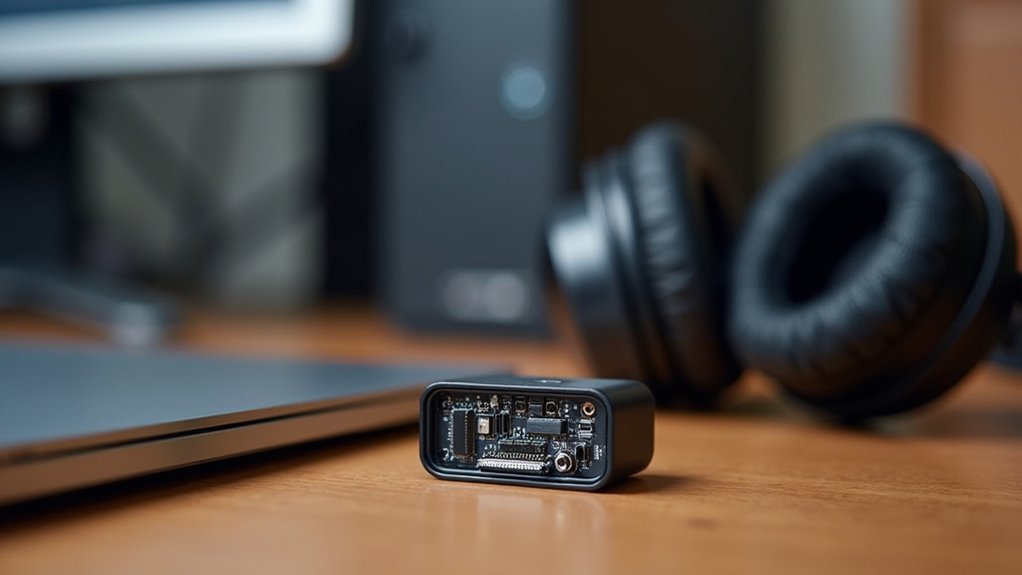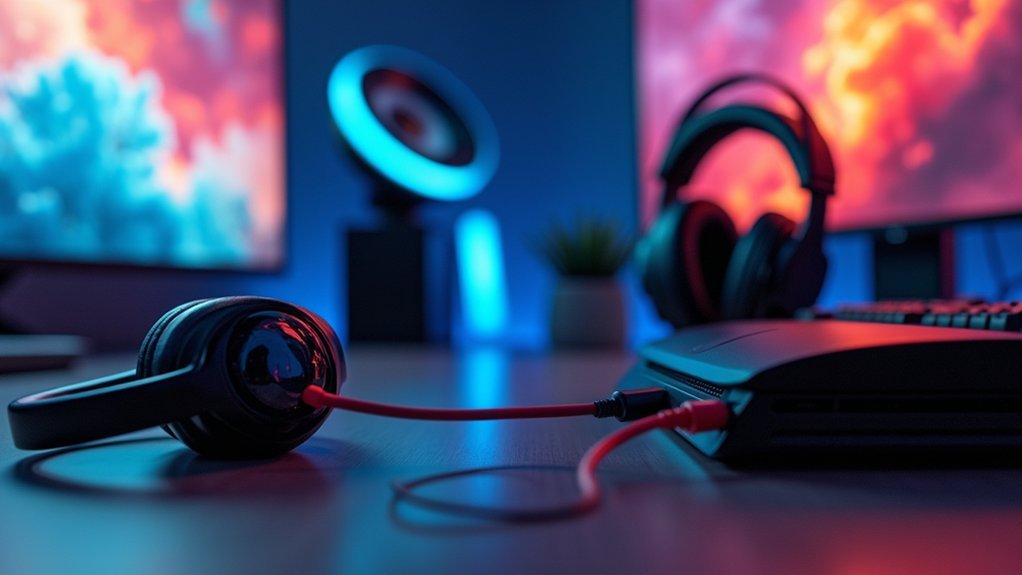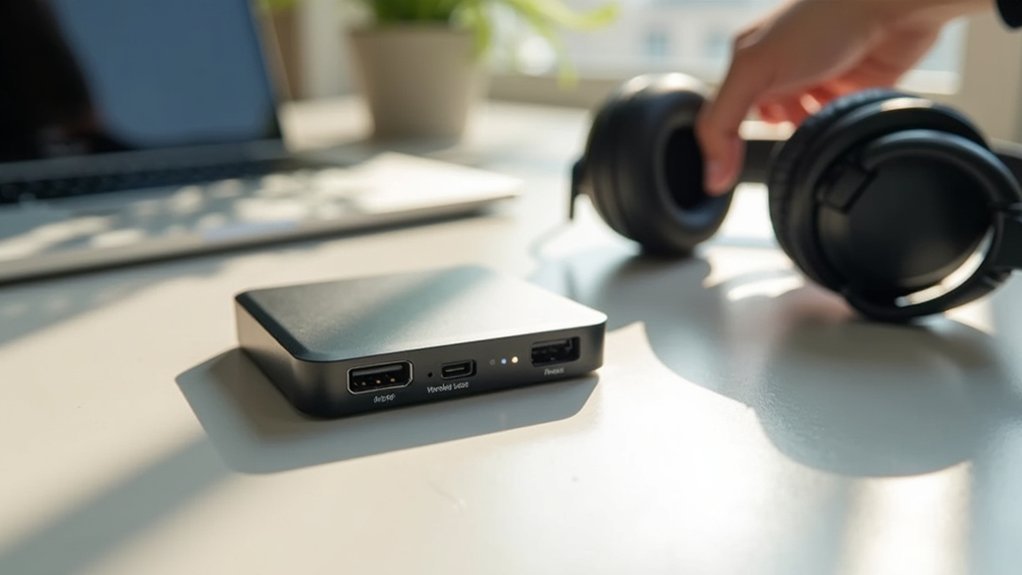You’ll need to evaluate your priorities between performance and mobility when choosing between wireless adapters and standalone headsets. Consider your available space, Wi-Fi bandwidth (800+ Mbps for 4K), budget ($299-$499 for standalone vs $1,000+ for tethered), and technical expertise for setup. Wireless adapters deliver superior graphics using your PC’s GPU but require complex installation, while standalone headsets offer 2-6 hour battery life with simpler setup but limited processing power. The following thorough analysis will guide your best decision.
Understanding Processing Power Requirements for Each Setup Type

When choosing between wireless adapters and standalone headsets, you’re fundamentally deciding between two fundamentally different processing approaches that’ll dramatically impact your VR experience.
Wireless VR adapters paired with tethered VR headsets leverage your PC’s powerful GPU, delivering superior graphics quality and complex virtual environments that push visual boundaries. Your desktop handles all computational heavy lifting, enabling high frame rates and resolution without battery constraints.
Conversely, standalone headsets rely on built-in processors with limited processing power. While convenient, they can’t match the graphical fidelity of PC-powered setups. Their internal chips must balance performance with battery life, resulting in compromises.
If you prioritize visual excellence and own a capable gaming PC, wireless adapters offer the best of both worlds. However, standalone headsets provide accessibility and portability for casual VR experiences.
Evaluating Your Available Physical Space and Movement Needs
Your available physical space dictates which wireless VR solution will work best for your setup.
Standalone headsets like the Meta Quest 2 and Pico 4 excel in smaller areas where cable management becomes problematic, offering complete freedom of movement without tethering concerns. These devices maximize your physical space efficiency since there’s no risk of cable entanglement.
Standalone VR headsets eliminate cable frustrations in tight spaces, delivering unrestricted movement and maximum efficiency for your play area.
Wireless adapters for tethered headsets require more substantial room to accommodate potential cable issues and guarantee peak performance.
Consider your play area’s height and width carefully – some VR experiences demand extensive full-body movement that’s more feasible with standalone options.
Clear your environment of furniture and low-hanging objects regardless of your choice.
Both wireless solutions depend on unrestricted movement for safe, immersive experiences that won’t compromise your enjoyment.
Comparing Graphics Quality Between Wireless and Tethered Options

Although standalone headsets offer unmatched convenience, tethered VR systems consistently deliver superior graphics quality thanks to the raw processing power of connected PCs.
You’ll notice significant differences in visual fidelity when comparing these options for your VR experience.
Here’s what affects graphics quality across different setups:
- Tethered headsets provide the highest visual quality with complex environments and high-resolution displays.
- Wireless adapters for tethered systems offer mobility but may reduce visual performance due to bandwidth constraints.
- Standalone headsets handle all processing internally, limiting graphics capabilities compared to PC-powered options.
- Network requirements for wireless streaming demand 80-120Mbps for 1080p and 800Mbps+ for 4K.
Your choice depends on whether you prioritize maximum graphics quality or wireless freedom.
Assessing Wi-Fi Infrastructure and Bandwidth Capabilities
You’ll need to evaluate your home network’s bandwidth capacity to determine if it can handle wireless VR’s demanding requirements.
Start by checking whether your router supports Wi-Fi 6 or 6E standards, as older models won’t sustain the necessary speeds for high-quality experiences.
Test your network’s latency and throughput under load to identify potential bottlenecks before investing in wireless VR equipment.
Bandwidth Requirements Analysis
When choosing between wireless adapters and standalone headsets, understanding your network’s bandwidth capabilities becomes essential for determining which option will deliver the best VR experience. Your network requirements vary considerably between these two approaches.
Here’s what you’ll need for peak performance:
- Low-resolution VR: Approximately 25 Mbps for basic wireless VR headsets
- Full HD (1080p): Between 80-120 Mbps for quality experiences
- 4K resolution: Over 800 Mbps for premium visual fidelity
- Peak performance: Sustained speeds exceeding 800 Mbps recommended
PCVR headsets demand robust connections to your gaming PC, while standalone units primarily use Wi-Fi for internet connectivity.
You’ll want dedicated 5GHz bandwidth for your headset to minimize latency. Consider tri-band or quad-band routers supporting Wi-Fi 6E technology, which can provide 2400 Mbps on 5GHz bands.
Router Compatibility Check
Before investing in wireless VR equipment, verifying your router’s capabilities prevents costly disappointments and guarantees smooth gameplay.
Router compatibility with wireless VR headsets demands Wi-Fi 6 or Wi-Fi 6E support to meet bandwidth requirements for peak performance. You’ll need sustained speeds exceeding 800Mbps on the 5GHz band, particularly for 4K resolutions.
Consider tri-band or quad-band routers if you’re running multiple headsets simultaneously. These provide additional 5GHz bands that prevent congestion and maintain consistent performance.
Dedicate a separate Wi-Fi network exclusively for VR use to minimize interference from other devices competing for bandwidth.
Don’t rely on advertised speeds alone—conduct actual speed tests in your VR play area. Real-world performance often differs from manufacturer specifications, and testing guarantees your infrastructure truly supports immersive wireless experiences.
Network Latency Testing
Network latency testing reveals whether your Wi-Fi infrastructure can handle real-time VR data transmission without causing motion sickness or visual artifacts.
Your wireless VR experience depends on maintaining sub-20 millisecond latency for smooth gameplay and immersion.
Follow these steps to conduct thorough latency tests:
- Run ping and traceroute commands to measure communication delays between your headset and PC.
- Test throughout your play area to identify weak signal zones and physical barriers affecting performance.
- Verify bandwidth capacity – confirm 25Mbps for low-resolution content or 80-800Mbps for HD/4K applications.
- Configure Quality of Service settings on your router to prioritize VR traffic and reduce network latency.
Testing multiple locations within your intended space ensures consistent Wi-Fi infrastructure performance across your entire play environment.
Calculating Total Cost of Ownership for Both Approaches
When you’re choosing between wireless adapters and standalone headsets, you’ll need to calculate both your upfront investment and ongoing expenses to make the smartest financial decision.
Your initial hardware costs vary dramatically—while a Quest 2 runs about $299, adding a wireless adapter to your existing tethered setup costs $300-400, plus you’ll need that $700-2,000 gaming PC to power it.
You’ll also face different long-term operating expenses, from battery replacements and app purchases for standalone units to potential PC hardware upgrades for tethered systems.
Initial Hardware Costs
Understanding the true cost of your VR setup requires looking beyond the sticker price of the headset itself.
Initial hardware costs vary dramatically between approaches, and you’ll need to evaluate your total investment carefully.
When comparing your options, consider these key cost factors:
- Standalone headsets like Meta Quest 2 cost $299-$499 with no additional requirements.
- Tethered setups need a powerful PC investment often exceeding $1,000.
- Wireless adapters add $100-$300 to your tethered headset’s base price.
- PC compatibility requirements may force expensive hardware upgrades.
Standalone headsets offer the most budget-friendly entry point since they contain built-in processing power.
Tethered setups demand significant upfront investment in both the headset and a capable computer, making them considerably more expensive initially.
Long-Term Operating Expenses
Beyond the upfront investment, you’ll face ongoing expenses that can greatly impact your VR budget over time.
Standalone headsets offer significant advantages in long-term operating expenses due to their self-contained design. You won’t need to maintain or upgrade an expensive gaming PC, which can save thousands annually.
Meanwhile, tethered VR headsets require continuous hardware upgrades to keep pace with demanding VR titles.
Your maintenance costs differ dramatically between options. Wireless adapters may need replacement, and PC components require regular updates.
Standalone headsets primarily need battery charging and software updates. You’ll also find affordable applications more readily available in standalone ecosystems compared to premium PCVR content.
Determining Setup Complexity and Technical Expertise Requirements

While both wireless adapters and standalone headsets aim to eliminate cables, they differ markedly in setup complexity and technical demands.
Wireless adapters require considerable technical expertise, involving router configuration, bandwidth optimization, and compatibility troubleshooting. You’ll need understanding of proprietary protocols, USB dongles, and latency management. The installation process often proves challenging for casual users.
Standalone headsets offer a dramatically more user-friendly experience. They come with built-in operating systems that eliminate complex PCVR installations, software downloads, and compatibility checks.
Consider these setup complexity factors:
- Technical knowledge requirements – wireless adapters demand networking expertise
- Installation processes – standalone headsets require minimal setup
- Troubleshooting complexity – adapters involve multiple failure points
- User accessibility – standalone options accommodate non-technical users better
For most users, standalone headsets provide the simpler path forward.
Analyzing Battery Life Impact on Extended VR Sessions
Battery life emerges as a critical differentiator when you’re planning marathon VR sessions that extend beyond casual gaming.
Standalone VR headsets typically deliver 2-6 hours of usage, with devices like Meta Quest 2 averaging 2-3 hours during intensive gaming. This limitation forces you to take recharging breaks during extended VR sessions, potentially disrupting immersion.
Wireless adapters offer a compelling alternative by tapping into your PC’s power supply, eliminating battery constraints entirely. However, you’ll need to weigh this advantage against potential latency issues that could affect your VR experience.
If you’re committed to standalone headsets, consider external battery packs to extend playtime, though they’ll add weight and bulk to your setup.
Remember that battery performance degrades over time, gradually reducing session duration.
Weighing Portability Benefits Against Performance Trade-offs
You’ll face a fundamental trade-off when choosing between wireless adapters and standalone headsets: mobility versus graphics quality.
Wireless adapters free you from cables but often sacrifice visual fidelity due to bandwidth limitations, while standalone headsets offer ultimate portability at the cost of processing power.
Battery life further complicates this decision, as wireless solutions drain power faster and limit your extended VR sessions.
Mobility Vs Graphics Quality
Two fundamental trade-offs define the wireless VR landscape: complete freedom of movement versus maximum visual fidelity.
When you’re choosing between standalone headsets and tethered devices with wireless adapters, you’ll face competing priorities. Standalone headsets deliver unmatched mobility, letting you experience VR anywhere without setup constraints.
However, their internal hardware limits graphics quality compared to PCVR solutions.
Tethered devices with wireless adapters offer a middle ground, but bandwidth limitations can still compromise visual performance.
Consider these key factors:
- Resolution demands – 4K VR requires 800+ Mbps bandwidth
- Processing power – External PCs deliver superior graphics capabilities
- Network stability – High-quality routers guarantee consistent performance
- Use priorities – Convenience versus premium visual experiences
Your choice ultimately depends on whether mobility or graphics quality matters most for your VR goals.
Battery Life Constraints
Beyond graphics considerations, power management becomes your next major hurdle when weighing wireless VR options.
Battery life constraints greatly impact your standalone headsets experience, limiting sessions to just 2-3 hours per charge. You’ll find yourself interrupting immersive gameplay for frequent recharging breaks, which disrupts longer gaming marathons or productivity sessions.
Wireless adapters offer a compelling alternative by drawing power directly from your PC, enabling extended playtime without battery concerns. You can enjoy hours-long VR experiences without worrying about sudden shutdowns mid-session.
However, this advantage comes with trade-offs in graphics performance since standalone headsets rely on built-in hardware. Consider how often you’ll prioritize uninterrupted, lengthy VR sessions versus the convenience of grab-and-go portability when making your decision.
Examining Software Library Compatibility Across Platforms
When choosing between wireless adapters and standalone headsets, software compatibility becomes a crucial factor that’ll directly impact your VR experience.
Understanding these differences will help you make the right decision for your needs.
Here’s how software compatibility varies across platforms:
- PCVR Access: Your wired headset with wireless adapters maintains full access to extensive Steam VR and PC libraries, offering advanced gaming and content creation applications.
- Standalone Limitations: Standalone headsets like Meta Quest operate on their own systems with limited app stores, restricting access to many PCVR titles.
- Hybrid Solutions: Meta Quest series can connect to PCs, providing both standalone convenience and PCVR compatibility when needed.
- Performance Differences: PCVR titles designed for powerful computers deliver superior visual fidelity compared to standalone versions.
Matching Device Choice to Your Primary VR Use Cases
Software compatibility insights alone won’t determine your ideal VR setup – your specific use cases should drive this decision.
If you’re pursuing high-end gaming or content creation, tethered PCVR with Wireless Virtual adapters delivers superior graphics quality and processing power. You’ll need bandwidth exceeding 800Mbps, but you’ll achieve desktop-level performance without cables.
For casual gaming and social experiences, standalone headsets like the Meta Quest 2 offer unmatched convenience. They’re perfect when portability matters more than visual fidelity.
However, their limited graphics capabilities and battery life make them unsuitable for extended intensive sessions.
Your primary use case determines everything: choose tethered PCVR with wireless adapters for demanding applications, or select standalone headsets for hassle-free, casual VR experiences.
Frequently Asked Questions
Is Wireless Better Than Wired Headsets?
You’ll find wireless headsets offer better convenience and mobility, but wired headsets deliver superior graphics quality and performance. Your choice depends on whether you prioritize flexibility or high-quality immersive experiences.
Is Pcvr Better Than Standalone?
PCVR offers you superior visual quality and performance through your PC’s processing power, while standalone headsets give you convenience and portability. You’ll get better graphics with PCVR but easier setup with standalone options.
Is It Worth Getting a VR Headset Without a PC?
You’ll find standalone VR headsets absolutely worth buying without a PC. They’re affordable, convenient, and offer impressive gaming experiences. You can always upgrade later or connect to a PC if needed.
What Is the Difference Between Standalone and Tethered VR?
You’ll find standalone VR headsets work independently with built-in processors, while tethered headsets connect to your PC. Standalone offers mobility but limited graphics; tethered provides superior visual quality requiring external hardware.





Leave a Reply